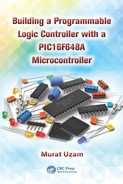Book Description
Programmable logic controllers (PLCs) are extensively used in industry to perform automation tasks, with manufacturers offering a variety of PLCs that differ in functions, program memories, and the number of inputs/outputs (I/O). Not surprisingly, the design and implementation of these PLCs have long been a secret of manufacturers. Unveiling the mysteries of PLC technology, Building a Programmable Logic Controller with PIC16F648A Microcontroller explains how to design and use a PIC16F648A-microcontroller-based PLC.
The author first described a microcontroller-based implementation of a PLC in a series of articles published in Electronics World magazine between 2008 and 2010. This book is based on an improved version of the project, including:
- Updates to the hardware configuration, with a smaller CPU board and two I/O extension boards that now support 16 inputs and 16 outputs instead of 8
- An increased clock frequency of 20 MHz
- Improvements to several macros
- Flowcharts to help you understand the macros (functions)
In this book, the author provides detailed explanations of hardware and software structures. He also describes PIC Assembly macros for all basic PLC functions, which are illustrated with numerous examples and flowcharts. An accompanying CD contains source files (.ASM) and object files (.HEX) for all of the examples in the book. It also supplies printed circuit board (PCB) (Gerber and .pdf) files so that you can have the CPU board and I/O extension boards produced by a PCB manufacturer or produce your own boards.
Making PLCs more easily accessible, this unique book is written for advanced students, practicing engineers, and hobbyists who want to learn how to build their own microcontroller-based PLC. It assumes some previous knowledge of digital logic design, microcontrollers, and PLCs, as well as familiarity with the PIC16F series of microcontrollers and writing programs using PIC Assembly language within an MPLAB integrated development environment.
Table of Contents
- Cover Page
- Half title
- title
- copy
- dedication
- preface
- ack
- fmchapter
- fmchapter
- Preface
- 1 Hardware of the PIC16F648A-Based PLC
- 2 Basic Software
- 3 Contact and Relay-Based Macros
- 3.1 Macro Id (load)
- 3.2 Macro ld_not (load not)
- 3.3 Macro not
- 3.4 Macro or
- 3.5 Macro or_not
- 3.6 Macro nor
- 3.7 Macro and
- 3.8 Macro and_not
- 3.9 Macro nand
- 3.10 Macro xor
- 3.11 Macro xor_not
- 3.12 Macro xnor
- 3.13 Macro out
- 3.14 Macro out_not
- 3.15 Macro in_out
- 3.16 Macro inv_out
- 3.17 Macro _set
- 3.18 Macro _reset
- 3.19 Examples for Contact and Relay-Based Macros
- 4 Flip-Flop Macros
- 4.1 Macro r_edge (Rising Edge Detector)
- 4.2 Macro f_edge (Falling Edge Detector)
- 4.3 Macro latchl (D Latch with Active High Enable)
- 4.4 The Macro latchO (D Latch with Active Low Enable)
- 4.5 Macro dff_r (Rising Edge Triggered D Flip-Flop)
- 4.6 Macro dff_f (Falling Edge Triggered D Flip-Flop)
- 4.7 Macro tff_r (Rising Edge Triggered T Flip-Flop)
- 4.8 Macro tff_f (Falling Edge Triggered T Flip-Flop)
- 4.9 Macro jkff_r (Rising Edge Triggered JK Flip-Flop)
- 4.10 Macro jkff_f (Falling Edge Triggered JK Flip-Flop)
- 4.11 Examples for Flip-Flop Macros
- 5 Timer Macros
- 6 Counter Macros
- 7 Comparison Macros
- 8 Arithmetical Macros
- 9 Logical Macros
- 10 Shift and Rotate Macros
- 11 Multiplexer Macros
- 12 Demultiplexer Macros
- 13 Decoder Macros
- 13.1 Macro decod_1_2
- 13.2 Macro decod_1_2_AL
- 13.3 Macro decod_1_2_E
- 13.4 Macro decod_1_2_E_AL
- 13.5 Macro decod_2_4
- 13.6 Macro decod_2_4_AL
- 13.7 Macro decod_2_4_E
- 13.8 Macro decod_2_4_E_AL
- 13.9 Macro decod_3_8
- 13.10 Macro decod_3_8_AL
- 13.11 Macro decod_3_8_E
- 13.12 Macro decod_3_8_E_AL
- 13.13 Examples for Decoder Macros
- 14 Priority Encoder Macros
- 15 Application Example
- 15.1 Remotely Controlled Model Gate System
- 15.2 Control Scenarios for the Model Gate System
- 15.3 Solutions for the Control Scenarios
- 15.3.1 Solution for the First Scenario
- 15.3.2 Solution for the Second Scenario
- 15.3.3 Solution for the Third Scenario
- 15.3.4 Solution for the Fourth Scenario
- 15.3.5 Solution for the Fifth Scenario
- 15.3.6 Solution for the Sixth Scenario
- 15.3.7 Solution for the Seventh Scenario
- 15.3.8 Solution for the Eighth Scenario
- About the CD-ROM
- References
- Index
